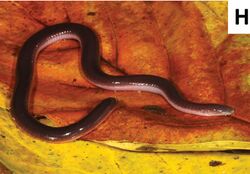Biology:Scolecomorphidae
| Scolecomorphidae | |
|---|---|

| |
| Scolecomorphus kirkii | |
| Scientific classification | |
| Domain: | Eukaryota |
| Kingdom: | Animalia |
| Phylum: | Chordata |
| Class: | Amphibia |
| Order: | Gymnophiona |
| Clade: | Apoda |
| Family: | Scolecomorphidae Taylor, 1969 |
| Genera | |
The Scolecomorphidae (from Greek: σκώλεκώς skólekós, 'wormlike' and Greek: μορφή morphḗ, 'form') are a family of caecilians[1] also known as tropical caecilians, buried-eyed caecilians,[1][2] or African caecilians.[3] They are found in Cameroon in West Africa, and Malawi and Tanzania in East Africa.[1] Caecilians are legless amphibians which superficially resemble worms or snakes.
Scolecomorphids have only vestigial eyes, which are attached to the base of a pair of tentacles underneath the snout. Unlike other caecilians, they have only primary annuli; these are grooves running incompletely around the body, giving the animal a segmented appearance. All other caecilians have a complex pattern of grooves, with secondary or tertiary annuli present. Also uniquely amongst tetrapods, the scolecomorphids lack a stapes bone in the middle ear.[4]
At least some species of scolecomorphids give birth to live young, retaining the eggs inside the females' bodies until they hatch into fully formed offspring, without the presence of a free-living larval stage.[4]
Taxonomy
Just six species of scolecomorphids are known, grouped into two genera, as follows:[1][2]
Family Scolecomorphidae
- Genus Crotaphatrema Nussbaum, 1985
- Crotaphatrema bornmuelleri (Werner, 1899), Bornmuller's caecilian, Cameroon
- Crotaphatrema lamottei (Nussbaum, 1981), Mont Oku caecilian, Cameroon
- Crotaphatrema tchabalmbaboensis Lawson, 2000, Cameroon
- Genus Scolecomorphus Boulenger, 1883
- Scolecomorphus kirkii Boulenger, 1883, Kirk's caecilian or Lake Tanganyika caecilian, East Africa
- Scolecomorphus uluguruensis Barbour and Loveridge, 1928, Uluguru black caecilian or Nyingwa caecilian, Tanzania
- Scolecomorphus vittatus (Boulenger, 1895), ribbon caecilian or banded caecilian, Tanzania
References
- ↑ 1.0 1.1 1.2 1.3 Frost, Darrel R. (2019). "Scolecomorphidae Taylor, 1969". Amphibian Species of the World: an Online Reference. Version 6.0. American Museum of Natural History. http://research.amnh.org/vz/herpetology/amphibia/Amphibia/Gymnophiona/Scolecomorphidae.
- ↑ 2.0 2.1 "Scolecomorphidae". AmphibiaWeb. University of California, Berkeley. 2019. http://www.amphibiaweb.org/lists/Scolecomorphidae.shtml.
- ↑ "Scolecomorphidae Taylor, 1969". Integrated Taxonomic Information System. https://www.itis.gov/servlet/SingleRpt/SingleRpt?search_topic=TSN&search_value=208552.
- ↑ 4.0 4.1 Nussbaum, Ronald A. (1998). Cogger, H.G.. ed. Encyclopedia of Reptiles and Amphibians. San Diego: Academic Press. p. 56. ISBN 978-0-12-178560-4.
- Nussbaum, Ronald A. and Mark Wilkinson (1989). "On the Classification and Phylogeny of Caecilians." Herpetological Monographs, (3), 1-42
- San Mauro, Diego; David J. Gower; Oommen V. Oommen; Mark Wilkinson; Rafael Zardoya (November 2004). "Phylogeny of caecilian amphibians (Gymnophiona) based on complete mitochondrial genomes and nuclear RAG1". Molecular Phylogenetics and Evolution 33 (2): 413–427. doi:10.1016/j.ympev.2004.05.014. PMID 15336675.
- San Mauro, Diego; Miguel Vences; Marina Alcobendas; Rafael Zardoya; Axel Meyer (May 2005). "Initial diversification of living amphibians predated the breakup of Pangaea". American Naturalist 165 (5): 590–599. doi:10.1086/429523. PMID 15795855. https://pure.uva.nl/ws/files/3880726/39160_170248y.pdf.
- San Mauro, Diego; David J. Gower; Tim Massingham; Mark Wilkinson; Rafael Zardoya; James A. Cotton (August 2009). "Experimental design in caecilian systematics: phylogenetic information of mitochondrial genomes and nuclear rag1". Systematic Biology 58 (4): 425–438. doi:10.1093/sysbio/syp043. PMID 20525595.
Wikidata ☰ Q387119 entry
 |

